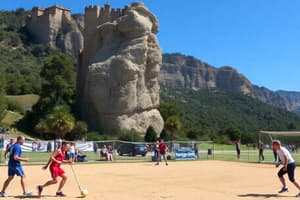Podcast
Questions and Answers
Match the recreational activity with its description:
Match the recreational activity with its description:
Cockfighting (sabong) = Popular form of gambling Basketball = Introduced by Americans in the early 20th century Boxing = Internationally competitive martial art Windsurfing = Widely practiced aquatic sport
Match the Filipino activity with its historical period:
Match the Filipino activity with its historical period:
Cultivation, hunting, and fishing = 15th century Introduced sports like basketball and tennis = Early 20th century Internationally competitive martial arts = Throughout history Cockfighting (sabong) = Throughout the country
Match the martial art with its origin:
Match the martial art with its origin:
Boxing = International Wushu = Filipino Tae kwon do = Korean Karate = Japanese
Match the recreational activity with its importance:
Match the recreational activity with its importance:
Match the American introduced sport with its popularity in the Philippines:
Match the American introduced sport with its popularity in the Philippines:
Match the tourism system component with its description:
Match the tourism system component with its description:
Match the element of tour guiding with its description:
Match the element of tour guiding with its description:
Match the characteristic of a tour guide with its explanation:
Match the characteristic of a tour guide with its explanation:
Match the limitation of a tour guide with its implication:
Match the limitation of a tour guide with its implication:
Match the reason why tourists need a guide with its explanation:
Match the reason why tourists need a guide with its explanation:
Flashcards are hidden until you start studying
Study Notes
Historical Timeline of Recreation
- Ancient Civilization (3000-4000 B.C.E.):
- Recreational activities varied from country to country
- Examples: hunting, boxing, wrestling, board games, music in Mesopotamia; ball games, archery, fishing in the Mayan World; swimming, fishing, board games, wrestling, music in Egypt; sports, exercise, boxing in Greece; sports, public baths, gambling, theatre performance in Rome
- Middle Age/Dark Age (500-1500 C.E.):
- Recreation centered around spiritual activities and holidays
- Hunting, archery, and tournaments were popular among the affluent
- Renaissance (1500-1600 C.E.):
- Period of cultural and intellectual revival
- Dance, music, tennis, golf, and fencing became popular among the affluent
- The Enlightenment (1685-1760 C.E.):
- Period of intellectual activity and scientific advancement
- Board games like chess, backgammon, and cards became popular
- Industrial Revolution (1760-1840 C.E.):
- Invention of photography, electricity, and telephone led to new leisure activities
- Steam engines enabled travel and tourism
- The Modern World (19th Century-Present):
- Rise of digital media, streaming services, and video games
- Increased popularity of outdoor activities like hiking, biking, and camping
- Sports like soccer and baseball became popular, and events like the Olympics and World Cup drew large audiences
History of Recreation in the Philippines
- 15th century Filipinos engaged in cultivation, hunting, and fishing
- Cockfighting (sabong) was a popular form of gambling, especially in Cebu
- Americans introduced sports like basketball, tennis, golf, and aquatic sports in the early 20th century
- Filipinos excelled in martial arts like boxing, wushu, and tae kwon do
Importance of Recreation in Human History
- Recreational activities are vital for physical and psychological well-being
- Taking breaks from daily routine can improve mental health and overall contentment
Tour Guiding
- Tour guides occupy a special position in the tourism system, forming part of the supply-side and intermediary components
- Characteristics of a tour guide include professionalism, service, interpretation, and physical elements
- Limitations of a tour guide: they cannot work alone and rely on others to provide the total tourism experience
- Why tourists need guides: to know about the destination, translate foreign languages, access non-public areas, manage limited time, and benefit from expertise
Studying That Suits You
Use AI to generate personalized quizzes and flashcards to suit your learning preferences.




